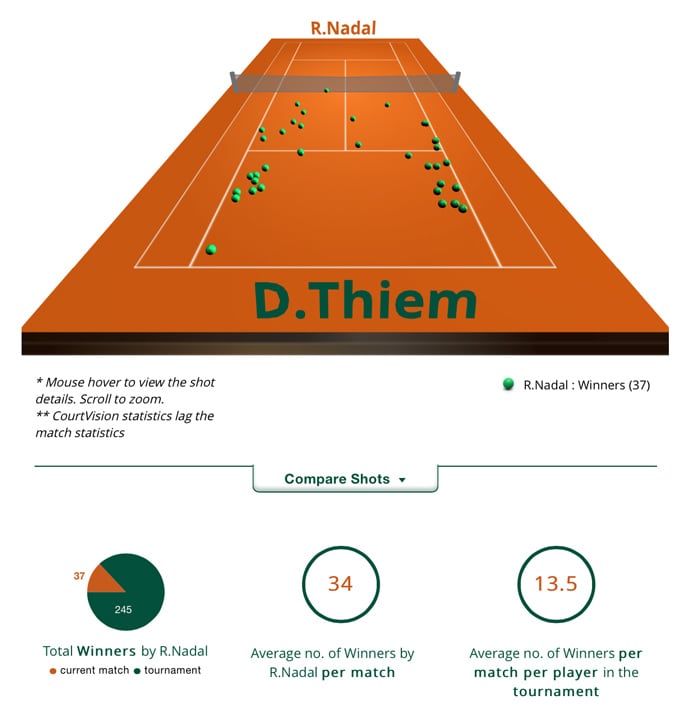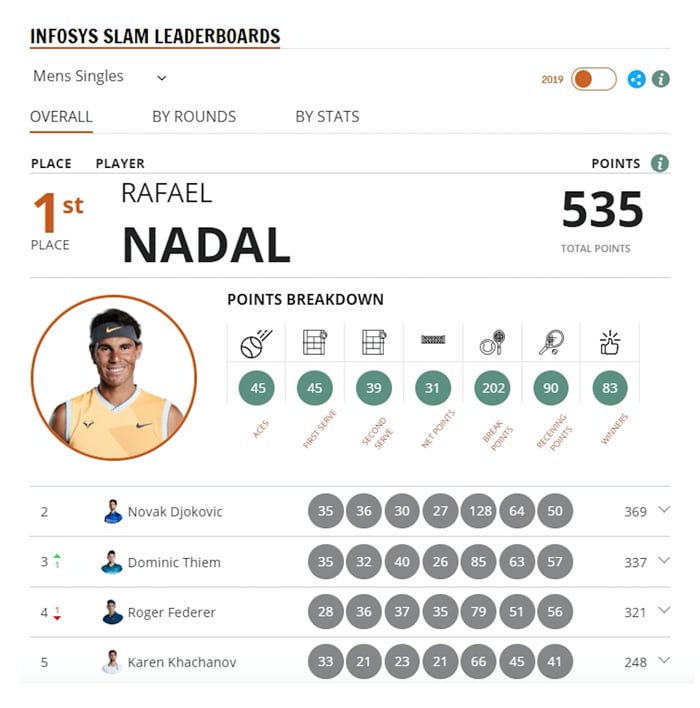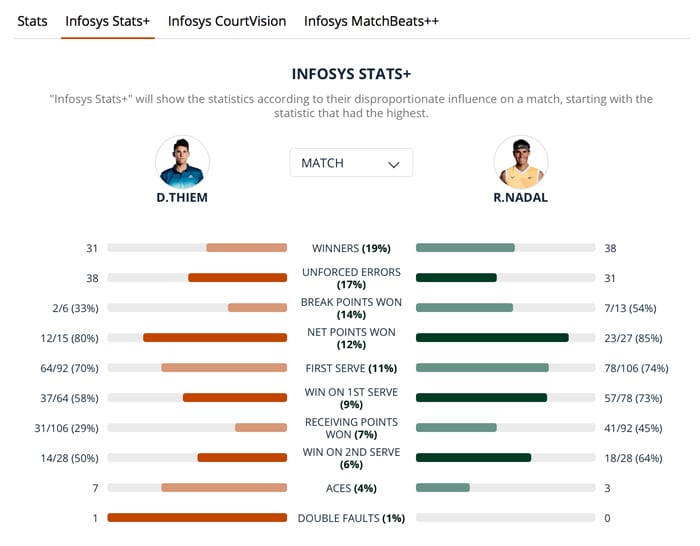AI/Automation
Infosys Serves an Ace at Roland-Garros with AI
In the end, Rafael Nadal cruised to a comfortable victory against Dominic Thiem in the French Open on the iconic red clay courts of Roland-Garros in Paris. Although the two players were seeded just two places apart—second and fourth, respectively—the gulf in quality told as the match progressed, with Nadal handsomely winning the third and fourth sets by six games to one.
But the ease with which Nadal finished the match disguised the fact that he faced a real challenge at the start. The first two sets were highly competitive, and tennis fans who were on the richly illustrated Infosys MatchCentre on the Roland Garros website, could watch the story unfold as the 11-time champion fought to assert his superiority in the early stages of the match. Be it the point-by-point progression of the match through MatchBeats, or the key statistics that influenced the match’s outcome through Stats+ or the insights and patterns on the different serves, returns, unforced errors and winners from the highly instrumented app CourtVision.
Thiem was actually the first to draw blood, breaking Nadal’s serve in the fifth game of the first set. But he failed to hold his own service in the following game, and eventually lost the set 3-6. In the second set, when Thiem showed unexpected promise, winning by seven games to five, the stats reveal a telling tale. Both players held their service in the first 10 games, and Nadal seemed to be building on the momentum of the first set by only conceding one point.
But in the 11th game, Thiem delivered an unexpected counterpunch, producing a stunning ace, with a serve reaching 206 kph/128 mph. Then, in the 12th game, he set up a break point after winning the longest rally of the set, and finally broke Nadal’s serve after another long rally to take the set.
The details of the tennis tournament, as experienced by the viewers on the ground, were presented in an at-a-glance visual interface, to fans from across the world as part of a new 3-year partnership between Infosys and Roland-Garros, which aims to “re-imagine” the tennis experience.
Infosys, which is at the forefront of digital innovation, wanted to find ways to showcase its expertise in technologies such as artificial intelligence (AI), big data and analytics, and virtual and augmented reality. It resolved to reach a worldwide C-suite audience by partnering with a major sport and considered various sports before deciding that tennis had a unique appeal for this first venture. Tennis made a lot of sense as the target audience was relevant for our business, and at the same time, it has global appeal.
The new partnership focuses on helping the French Tennis Federation, which organizes the Roland-Garros tournament, deepen its engagement with its most loyal fans. It “will offer tennis fans an even richer experience,” said Bernard Giudicelli, the federation’s president. The Paris stadium, with its newly upgraded courts, attracts nearly 500,000 spectators during the French Open, as Roland-Garros is known. But the tournament is also broadcast to 224 countries and attracts a vast audience that Infosys hopes to reach with its digital wizardry.
An immersive technology
Infosys subjects videos of every match to in-depth digital analysis using AI, producing an extraordinary array of data that is then sliced and diced in different ways to engage the most committed tennis super-fan. There are fans who watch a game and move on, right? And then there are fans who watch and obsess about the game. Our products cater to those who watch and obsess because they really want to get into the game. They say, “OK, what happened? Where did this go wrong? Where did he lose points? Where did the match change track?”
Infosys developed six separate immersive products—five focused on fans, and one focused on players and coaches. There is MatchBeats to decode the quality of the play, helping fans identify the winners from the losers. MatchBeats++, a special application offers a set-by-set view of the match.
CourtVision offers a bird’s eye view of the court and shows where each point was won and lost. Slam Leaderboards rank the top 10 players based on points scored with shots that have a significant bearing on a match’s outcome. Stats+ shows all the key statistics ranked according to their disproportionate influence on a match.
The core product is MatchBeats, which allows fans to follow the intensity of the match by highlighting hard-fought moments. It spots the crucial points, finding the aces and showing how the momentum shifted at break points. It decodes the quality of play, enabling fans to filter by outright winners, unforced errors and double faults. And for fans wanting to drill down further, there is MatchBeats++, a special application that offers a set-by-set view of the match.
A second product, CourtVision, offers fans a bird’s-eye view of the court and shows where each point was won and lost. Coming into the match, Nadal and Thiem hit an average of 34 outright winners in the previous rounds—way more than the tournament average of 13.5. But in their head-to-head, Nadal came out on top because he scored 38, compared to Thiem’s 31. CourtVision shows the exact location of the winning shots, and whether they were passing shots, volleys, drop or lob shots, or overhead smashes.
Figure 1: A snapshot of Courtvision showing where Nadal’s winning shots landed

Another product is Slam Leaderboards. This ranks the top 10 players based on points scored with shots that have a significant bearing on a match’s outcome, including aces, first serve, second serve, net points, break points, receiving points and winners.
Over the course of the tournament, Nadal’s 535 points placed him way ahead of second-place Novak Djokovic (369 points), who was knocked out by Thiem in the semi-final. Thiem finished third with 337 points. Nadal outscored his rivals in break points and receiving points, although he was the lowest rated of the players in the top 10 when ranked by serve.
A fourth data product, Stats+, shows all the key statistics ranked according to their disproportionate influence on a match. For example, while Thiem hit seven aces—compared to Nadal’s three—this category only made a 4% contribution to the outcome of the match. By contrast, Nadal’s winners made a 19% contribution to the result.
Figure 2: Infosys Slam Leaderboard

Figure 3: Infosys Stats+ showing statistics with a disproportionate influence on the match

In a sense, Infosys is giving fans the kind of data that players and coaches have been able to use to improve their performance. But even players are awed by Infosys’ technology. In fact, Infosys has built a dedicated portal for players and coaches, giving them access to more than 1,000 statistical combinations that identify their own and their opponent’s strengths and weaknesses.
Looking to the future: other sports and Wimbledon
Already, Infosys has received positive feedback from fans, players and coaches. Long-term, it plans to take its products to other sports. Tennis is where Infosys is starting , but we expect to go beyond that, take up other sports, and build similar capabilities.
But Infosys’ immediate plans are to deepen its coverage of tennis. It is planning to “work more closely” with the ATP, the governing body of the men’s professional tennis circuit, and develop its relationship with the Australian Open, which piloted some of its AI products in January 2018.




